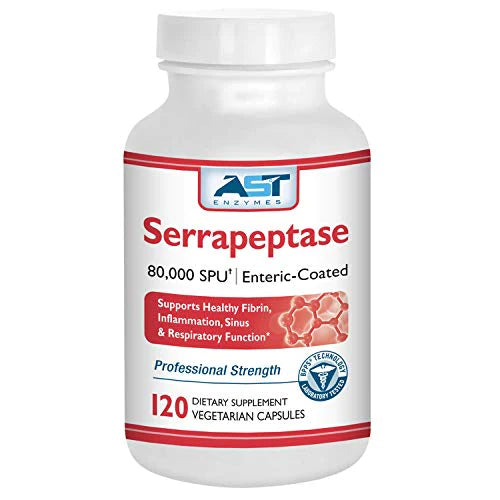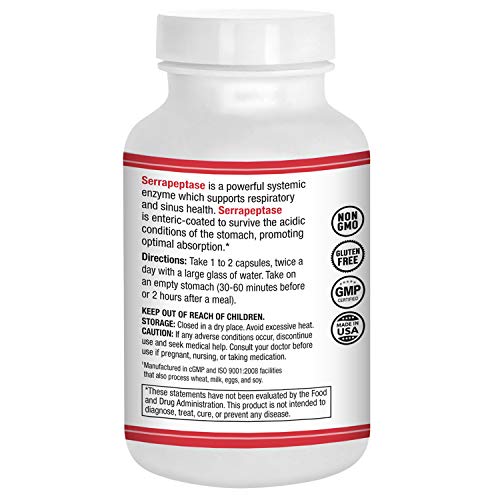

Gary Moller
AST Serrapeptase - 120 caps
AST Serrapeptase - 120 caps
15 Heaton Terrace
15 Heaton Terrace
Brooklyn
WGN
Wellington 6021
New Zealand
Serrapeptase Enteric Coated Serrapeptase
The Problem with Discomfort
Systemic enzymes are key to a healthy lifestyle. Processed food, exposure to environmental toxins and occasional illness cause the body to use up these enzymes, forcing it to work even harder to make these enzymes and use them in the many complex reactions that take place every moment in our bodies.
Many people reach for NSAIDs (non-steroidal anti-inflammatory drugs) such as aspirin, ibuprofen and naproxen to address discomfort. They are effective but come with serious side effects such as gastric bleeding, joint/cartilage damage, disrupted metabolism, increased blood sugar, loss of bone and emotional disorders, among others. In July of 1998, The American Journal of Medicine stated the following about NSAID-related gastrointestinal and metabolic complications:
“Conservative calculations estimate that approximately 107,000 patients are hospitalized annually for non-steroidal anti-inflammatory drug (NSAID)-related gastrointestinal (GI) complications and at least 16,500 NSAID-related deaths occur each year among arthritis patients alone. The figures of all NSAID users would be overwhelming, yet the scope of this problem is generally under-appreciated.”
An all-natural systemic enzyme, serrapeptase is a catalyst that stimulates and alters the body’s own capacity to recover with minimal side effects.
Serrapeptase (Peptizyme-SP®) for Healthy Fibrin Metabolism
Serrapeptaseis a powerful systemic enzyme that promotes total body support. Being the most powerful serrapeptase on the market, Serrapeptase is unrivaled among products of its kind because it is packed with 130K SPU per capsule (80K is also available), the strongest in the world. Serrapeptase – also known by serrapeptidase, serratiopeptidase and serratia peptidase - is a powerful proteolytic enzyme derived from a species of bacteria originally found in the intestine of silkworms. The bacterium, Serratia mercesans, produces the enzyme serrapeptase to enable the silkworm to dissolve its silken cocoon and emerge as a moth after metamorphosis. Don’t worry – no worms were harmed in the making of Serrapeptase. Serratia is now grown in cultures to produce serrapeptase by fermentation.
How do SU’s relate to IU’s?
Enzyme activity is often measured through a FCC (Food Chemicals Codex) or USP (United States Pharmacopeia) assays and is indicated by IU (international unit). Some enzymes don’t have a standard FCC or USP assay, such as serrapeptase. However, Japanese Pharmacopeia (JP) has established an activity assay specific for serrapeptase, which measures activity in SPU, or serrapeptase unit.
IU or SU is used interchangeably on different serrapeptase products. While we do not know what sort of assays other companies use to test their enzymes, you can still compare the activity level on a one-to-one basis. Unlike other supplements, the weight (mg) of an enzyme supplement carries no significance. It is not the amount but the potency, or activity, of the enzyme that really matters. Guaranteeing the ingredients are available to the body is more important than how much of the ingredient is listed on a supplement label.
NOTE: It is important to continue “therapeutic doses” until results are seen. This should then be reduced to a “maintenance dose” of 1-3 capsules two times a day.
Serrapeptase (Peptizyme-SP®)can be used along with other systemic enzyme blends such as Exclzyme or Serracor-NK to support fibrinolytic activity and mucus viscosity in the respiratory system.* This trademark is an absolute guarantee of quality.
Research
Serrapeptase has been thoroughly researched for its numerous and diverse effects on the immune response.
Researchers in India conducted a study to assess the response of serrapeptase in patients with carpal tunnel syndrome (CTS). They wanted to determine if a conservative, non-surgical approach would be beneficial. Twenty patients with CTS were evaluated clinically after 6 weeks taking serrapeptase. Sixty five percent showed significant clinical improvement, which was supported by improvement in electrophysiological parameters. No significant side effects were observed. The doctors concluded that serrapeptase therapy may prove to be a useful alternative conservative treatment.1
A clinical evaluation of serrapeptase was conducted to determine its efficacy in reducing the symptoms in patients with breast engorgement. Serrapeptase was noted to be superior to placebo for improvement of breast pain, breast swelling and induration and while 85.7% of the patients receiving serrapeptase had "Moderate to Marked" improvement. No adverse reactions were reported with the use of serrapeptase. The researchers conclude that serrapeptase is a safe and effective method for the treatment of breast engorgement.2
A prospective study was conducted on the effect of serrapeptase on post-operative swelling and pain of the ankle. In the serrapeptase group, the swelling decreased by 50% on the third post-operative day, while in the control groups (no treatment and treatment with ice) no reduction in swelling occurred. A decrease in pain correlated for the most part with the reduction in swelling. On the basis of these results, serrapeptase would appear to be an effective preparation for the post-operative reduction of swelling, in comparison with the classical conservative measures, for example, the application of ice.3
The efficacy of serrapeptase was evaluated in a multicenter, double-blind, placebo-controlled study of 193 subjects suffering from acute or chronic ear, nose or throat disorders. After 3-4 days' treatment, significant symptom regression was observed in serrapeptase treated patients. Statistical comparison confirmed the greater efficacy of serrapeptase against all the symptoms examined. It was concluded that serrapeptase has anti-edemic and fibrinolytic activity and acts rapidly on localized areas.4
Serrapeptase is widely used in clinical practice in Japan. One research trial in Japan investigated the effect of serrapeptase on sputum properties and symptoms in patients with chronic airway diseases. After 4 weeks of serrapeptase treatment, sputum output, viscosity and sputum neutrophil count decreased significantly. In addition, the frequency of coughing and of expectoration also decreased. The researchers concluded serrapeptase may exert a beneficial effect on mucus clearance by reducing neutrophil numbers and altering the viscoelasticity of sputum in patients with chronic airway diseases.5
An unusual clinical trial evaluated the effectiveness of serratiopeptidase in the eradication of a periprosthetic infection (an infection at the site of an implanted orthopedic device) in an in vivo animal model. Infections of slime-forming bacteria are especially difficult at these sites. Rats were inoculated with Staphylococcus epidermidis at the prosthetic site. After two weeks, infection persisted in 63.2% of animals in the no-treatment group; 37.5% of animals in an antibiotic-only group; and only 5.6% of animals in the serratiopeptidase-and-antibiotic group. The authors conclude that serratiopeptidase was effective at eradicating infection in this experimental animal model and may enhance antibiotic efficacy in the treatment of staphylococcal infections.6
References
1. Panagariya A, Sharma AK. A preliminary trial of serratiopeptidase in patients with carpal tunnel syndrome. J Assoc Physicians India. 2000 Nov;48(11):1130.
2. Kee WH, Tan SL, Lee V, Salmon YM. The treatment of breast engorgement with Serrapeptase (Danzen): a randomised double-blind controlled trial. Singapore Med J. 1989 Feb;30(1):48-54.
3. Gerngross H, Fabian A. Reduction of postoperative swelling. Objective measurement of swelling of the upper ankle joint in treatment with serrapeptase-- a prospective study(German). Fortschr Med. 1989 Feb 10;107(4):67-8, 71-2. Esch PM,
4. Mazzone A, Catalani M, Costanzo M, Drusian A, Mandoli A, Russo S, Guarini E, Vesperini G. Evaluation of Serratia peptidase in acute or chronic inflammation of otorhinolaryngology pathology: a multicentre, double-blind, randomized trial versus placebo.J Int Med Res. 1990; 18(5):379-88.
5. Nakamura S, Hashimoto Y, Mikami M, Yamanaka E, Soma T, Hino M, Azuma A, Kudoh S. Effect of the proteolytic enzyme serrapeptase in patients with chronic airway disease. Respirology. 2003 Sep;8(3):316-20.
6. Mecikoglu M, Saygi B, Yildirim Y, Karadag-Saygi E, Ramadan SS, Esemenli T.
The effect of proteolytic enzyme serratiopeptidase in the treatment of experimental implant-related infection. J Bone Joint Surg Am. 2006 Jun;88(6):1208-14.
FAQ
|
What is systemic enzyme therapy? Systemic enzyme therapy refers to the therapeutic use of natural enzymes to produce desired healing effects. Systemic enzymes are absorbed from the small intestine where they enter the bloodstream and execute their effects on the entire body as a system. Their crucial role in normal inflammatory response assists and supports the body in accelerating healing.
What is a systemic proteolytic enzyme? Proteolytic enzymes break down proteins into their building-blocks, which are called amino acids. Systemic proteolytic enzymes are responsible for breaking down accumulated protein and waste substances found in the circulatory system and connective tissue. Waste materials produced from inflammation and other biochemical processes can build up, contributing to excessive scarring and perpetuated immune responses. Excessive scarring, particularly of the organs, can exacerbate symptoms of the associated disease. The waste product of specific concern is known as fibrin. Regular systemic proteolytic enzyme use can improve circulation and aid in flushing out these waste products.
What is fibrin? Fibrin is a protein-based substance that is needed to help clot one’s blood, playing a substantial role in immune response and healing. When the body responds to injury or chronic inflammation, fibrin is recruited to the damaged area to form scar tissue. Although the body is equipped with plasmin, a naturally occurring enzyme responsible for breaking down excess fibrin, some people are at a disadvantage – as aging occurs, plasmin levels progressively decrease. This actually increases the risk for excessive, undesirable scar tissue formation in the body.
Are systemic enzymes anti-inflammatory drugs? Although systemic enzymes produce anti-inflammatory effects, they are not considered a drug. Since enzymes are naturally occurring within the body, systemic enzyme therapy is considered supplementation. One difference between systemic enzymes and NSAIDs (Non-steroidal anti-inflammatory drugs) involves the duration of action. While NSAIDs produce short-term pain relief, systemic enzymes can produce long-term alleviation with appropriate use. The largest difference between NSAIDS and systemic enzymes is the mechanism of action and possible side effects. NSAIDs block the production of prostaglandins, which are responsible for inflammation and swelling. However, prostaglandins protect the lining of the stomach, and prolonged use of NSAIDs can reduce this protection and increase the risk of developing ulcers. Conversely, regular use of systemic enzymes has no negative side effects and can actually provide protective effects against excess inflammation.
Why is it important to take Peptizyme-SP on an empty stomach? Since most absorption occurs in the small intestine, the systemic enzymes must bypass the stomach to gain access there. If the enzymes are taken with food, they will likely begin working to break down your food within the stomach, rather than passing through to the small intestine. Taking systemic enzymes like Peptizyme-SP with food will compromise their absorption, as well as their effectiveness.
Does Peptizyme-SP have an enteric coating? Yes, the serrapeptase in Peptizyme-SP is enterically coated. While similar systemic enzymes may have the same active ingredients, most do not utilize enteric coating. The purpose of enteric coating is to protect the enzyme from the acidic environment of the stomach. High activity level is preserved until the enzymes reach the small intestine, where absorption into the bloodstream takes place. While the enteric coating can withstand the acidic environment of the stomach, the alkaline environment of the small intestine will disintegrate the enteric coating, allowing the enzyme to be active within the bloodstream.
Do you use phthalates in your enteric coating? No, our enteric coating does not use or contain phthalates. At AST Enzymes, we use Methacrylic Acid Copolymer (MAAC) for our enteric coating. Compared to other commonly used enteric coating agents such as Cellulose Acetate Phthalate (CAP) and Hydroxypropyl Methycellulose Phthalate (HPMCP), MAAC is the most gastro-resistant and does not carry the same risks. Additionally, MAAC is considered GRAS (Generally Recognized as Safe) by the FDA and is approved for use by the European Food Safety Authority. To learn more about enteric coating used in AST Enzymes products, please see our “Compare” tab.
How long should I take Peptizyme-SP before feeling results? Since people experience varying ailments and severity of disease, the length of time to include systemic enzymes in your regimen may vary as well. As an overall guideline, it is typically recommended that new systemic enzyme users start off slow. A starter dose is generally one capsule, three times daily. After one week of proven tolerance, the dose can be increased to a therapeutic dose of 2 capsules, 3 times per day. At this point, results may be monitored, and dosage should be adjusted accordingly. Some consumers find their therapeutic dose between 6 to 9 capsules per day, while others only need 2 to 3. There are several factors that may affect results and required dosage, including: Height Weight Age Severity of symptoms Tolerance Time of administration (Better absorbed on an empty stomach) Adherence to regimen Nutritional state
What if I miss a dose? Regular, consistent use of systemic enzymes will provide the best results, however missed doses of systemic enzymes do not have serious repercussions. Although symptoms alleviated by systemic enzyme therapy may resurface, getting back on track by remembering to take your next dose will suffice. There is also the option of incorporating another dose during the day. There is no need to “double up,” on one dose - and remember, systemic enzymes are best absorbed on an empty stomach.
Are there any side effects involved with Peptizyme-SP? The use of Peptizyme has not been shown to exhibit detrimental effects, neither long term nor short term. Just as dosage requirements vary, side effects may vary as well. Although gastrointestinal disturbances have been reported by a small percentage of new users, tolerance is maintained once the dosage is adjusted. Minor allergic reactions, like reddening of the skin, are also rare occurrences, and can be seen with extremely high doses. There are no known interactions with prescription or over the counter drugs while using systemic enzyme therapy. However, it is recommended that you consult with your physician about starting systemic enzymes, especially if you are currently on blood-thinning medications or if you are pregnant or nursing.
Can I take Peptizyme-SP with other systemic enzymes? Systemic enzymes may be taken together, yielding desirable results, as long as they are taken on an empty stomach. In fact, it is often recommended that systemic enzymes be combined. Products Peptizyme-SP and Serracor-NK often have synergistic effects when taken together. This means that the separate products work together to produce advantageous results. By combining and enhancing the activity of the enzymes, their effects on the healing process are more attainable.
Can I take Peptizyme-SP with digestive enzymes? Although digestive and systemic enzymes are not contraindicated in terms of ingredients, they cannot be taken at the same time. The purpose of digestive enzymes is to aid in digestion of specific foods, so taking them with food is an obvious recommendation. Because systemic enzymes require an empty stomach for maximum absorption, they must be taken separately from digestive enzymes. There are no adverse interactions between systemic and digestive enzymes, but they serve different purposes and thus should be taken as directed for best results. |



